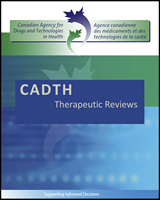Except where otherwise noted, this work is distributed under the terms of a Creative Commons Attribution-NonCommercial- NoDerivatives 4.0 International licence (CC BY-NC-ND), a copy of which is available at http://creativecommons.org/licenses/by-nc-nd/4.0/
NCBI Bookshelf. A service of the National Library of Medicine, National Institutes of Health.
New Oral Anticoagulants for the Prevention of Thromboembolic Events in Patients with Atrial Fibrillation: Recommendations [Internet]. Ottawa (ON): Canadian Agency for Drugs and Technologies in Health; 2012 Jun.

New Oral Anticoagulants for the Prevention of Thromboembolic Events in Patients with Atrial Fibrillation: Recommendations [Internet].
Show detailsAtrial fibrillation (AF), the most common cardiac rhythm abnormality, is associated with substantial morbidity. AF-related mortality is mainly attributable to complications of stroke. Stroke risk can be quantified using a validated tool such as the CHADS2 score.1 Warfarin, a vitamin K antagonist, is the standard of care for patients with AF and has demonstrated efficacy in the prevention of stroke.2 Warfarin has a narrow therapeutic window, produces varied responses among patients, and interacts with some types of food and other drugs, all of which necessitates routine laboratory monitoring.3,4
Improved understanding of the blood clotting cascade has led to the development of several new oral anticoagulants (NOACs) that offer a more targeted mechanism of anticoagulation. These NOACs include the direct thrombin inhibitor, dabigatran, and the direct factor Xa inhibitors, rivaroxaban and apixaban, which have either been approved (dabigatran and rivaroxaban) for use or are currently under regulatory review (apixaban) for the prevention of stroke and systemic embolism (SE) in patients with AF.
Although NOACs have demonstrated efficacy within clinical trials in preventing stroke and SE in patients with AF, the relative effectiveness and cost-effectiveness in clinical practice of these agents is not clear. In addition, the relative effectiveness and cost-effectiveness of the NOACs and warfarin within specific subpopulations of AF patients is not clear.
Evidence-informed recommendations were developed by the Canadian Drug Expert Committee (CDEC) to address the following policy questions:
- Are there sub-populations of AF patients that would benefit more from using NOACs compared to warfarin?
- Are there sub-populations of AF patients that would benefit more from one of the NOACs versus another?
At the time of this report, apixaban was not approved by Health Canada for the prevention of stroke and SE in patients with non-valvular AF. Therefore, while the science reports included apixaban in addition to rivaroxaban and dabigatran, the recommendations presented in this report apply at present only to the two NOACs that are approved for this indication in Canada, namely dabigatran and rivaroxaban.
The evidence for developing recommendations was derived from the following CADTH reports:
- Canadian Collaborative for Network Meta-Analysis for Drug Safety and Effectiveness Project Team (DSEN-NMA Project Team). Safety, effectiveness, and cost-effectiveness of new oral anticoagulants compared with warfarin in preventing stroke and other cardiovascular events in patients with atrial fibrillation [Internet]. Ottawa: Canadian Agency for Drugs and Technologies in Health; 2012 Apr. [cited 2012 Apr 9]. Available from: http://www.cadth.ca/en/products/therapeutic-reviews/anticoagulants/reports
- Canadian Agency for Drugs and Technologies in Health. Anticoagulation monitoring and reversal strategies for dabigatran, rivaroxaban, and apixaban: A review of clinical effectiveness and cost [Internet]. Ottawa: The Agency; 2012 Apr. [cited 2012 Apr 9]. Available from: http://www.cadth.ca/en/products/therapeutic-reviews/anticoagulants/reports
The analysis in the abovementioned reports was limited by the small number of randomized controlled trials (RCTs), and the heterogeneity of patient populations, trial design, definitions of outcomes, and reporting of results of the included RCTs.
The Committee considered the evidence and its limitations primarily from a population-based perspective. The anticipated absolute benefits, harms, and cost-effectiveness of the NOACs compared with warfarin were considered to be fundamental in the development of system-level recommendations. The Committee also recognized that clinical guidelines related to the use of the NOACs have been developed based on clinical judgment and consideration of individual patient characteristics.
- BACKGROUND - New Oral Anticoagulants for the Prevention of Thromboembolic Events...BACKGROUND - New Oral Anticoagulants for the Prevention of Thromboembolic Events in Patients with Atrial Fibrillation: Recommendations
Your browsing activity is empty.
Activity recording is turned off.
See more...